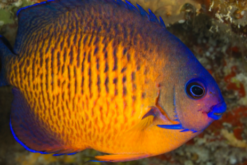Saltwater Aquarium Guide: Coral Beauty Angelfish (Centropyge bispinosus)
Quick Stats:
- Care Level: Moderate
- Temperament: Semi-aggressive
- Diet: Omnivore
- Reef Safe: With Caution
- Minimum Tank Size: 40 gallons
- Max Size: Up to 4 inches
- Water Parameters: pH 8.1-8.4, Salinity 1.020-1.025, Temperature 72-78°F
Comprehensive Guide: Coral Beauty Angelfish (Centropyge bispinosus)
The Coral Beauty Angelfish, or Centropyge bispinosus, is popular among saltwater aquarium enthusiasts. This comprehensive guide will provide you with all the information you need to know about this beautiful fish.
Habitat
The Coral Beauty Angelfish is found in the Indo-Pacific region, specifically in the reefs of the Indian Ocean and the Western Pacific Ocean. It prefers areas with plenty of hiding spots and caves, as well as coral-rich environments.
Reef Safe
The Coral Beauty Angelfish is generally considered reef-safe with caution. While it usually doesn’t bother most corals, it may nip at certain coral polyps and clam mantles. It’s important to carefully monitor its behavior and provide appropriate tank conditions.
Size
The Coral Beauty Angelfish can grow up to 4 inches long, making it a relatively small angelfish species. Its vibrant colors and intricate patterns make it a visually striking addition to any aquarium.
Temperament
This species is known to be semi-aggressive, especially towards other angelfish and similarly shaped fish. It may also display territorial behavior, so providing ample hiding spots and territories within the tank is essential.
Sexual Dimorphism
There are no distinct visual differences between male and female Coral Beauty Angelfish. They exhibit similar coloration and patterns, making it challenging to determine their gender without genetic testing.
Lifespan
The average lifespan of a Coral Beauty Angelfish is around 5 to 7 years. With proper care and a suitable environment, they can live even longer.
Diet in Aquariums
The Coral Beauty Angelfish is an omnivore with a varied diet. It should be fed high-quality marine pellets, frozen foods such as brine and mysis shrimp, and fresh or frozen meaty foods like chopped seafood. Providing a balanced diet is crucial for their overall health and coloration.
Aquascaping Recommendations
When setting up the aquarium for the Coral Beauty Angelfish, it’s important to create a well-structured environment with plenty of hiding spots and caves. Live rock formations and coral structures can provide visual appeal and functional spaces for the fish to explore and claim as territories.
Captive Bred Availability
the Coral Beauty Angelfish is available as captive-bred specimens. Captive-bred fish are generally hardier and better adapted to aquarium life compared to wild-caught specimens. They also help reduce the impact on wild populations and promote sustainable aquarium practices.
Compatibility with Other Fish, Invertebrates, or Corals
The Coral Beauty Angelfish can be kept with various tankmates, but caution should be exercised when selecting companions. It’s best to avoid keeping them with other angelfish or similarly shaped fish to minimize aggression and territorial disputes. Here are five specific tankmates that are generally compatible:
- Clownfish: They are peaceful and can coexist with the Coral Beauty Angelfish, creating a vibrant and diverse aquarium.
- Gobies: These small, peaceful fish can add interesting behavior and color contrast to the tank.
- Damsels: Certain damselfish species, such as the Blue Devil Damsel, can cohabitate with the Coral Beauty Angelfish.
- Blennies: These curious fish can make great tankmates, as they tend to stay near the bottom of the tank and have different feeding habits.
- Wrasses: Some wrasses, like the Six-Line Wrasse, can coexist peacefully with the Coral Beauty Angelfish while adding movement and activity to the tank.
Other Common Names
The Coral Beauty Angelfish is also known by other common names, such as Two-spined Angelfish and Dusky Angelfish.
Why Buy from Reefs4Less.com
Reefs4Less.com is a reputable online retailer specializing in saltwater aquarium supplies. They offer a wide range of high-quality fish, corals, and other livestock. With their expertise and commitment to customer satisfaction, Reefs4Less.com ensures that you receive healthy and well-cared-for specimens for your saltwater aquarium.
Popular Questions and Answers about the Coral Beauty Angelfish (Centropyge bispinosus)
Q: What is the ideal tank size for a Coral Beauty Angelfish?
A: The minimum tank size for a Coral Beauty Angelfish is 40 gallons, but providing a larger tank, such as a 55-gallon or 75-gallon tank, will offer more swimming space and better accommodate its territorial behavior.
Q: Can the Coral Beauty Angelfish be kept in a reef aquarium?
A: The Coral Beauty Angelfish can be kept in a reef aquarium. However, caution should be exercised as it may nip at certain coral polyps and clam mantles. It’s essential to carefully monitor its behavior and provide appropriate tank conditions.
Q: How often should I feed my Coral Beauty Angelfish?
A: It is recommended to feed the Coral Beauty Angelfish twice a day, offering a variety of high-quality marine pellets, frozen foods, and fresh or frozen meaty foods. Providing small, frequent meals will help maintain its health and vibrant coloration.
Q: Can the Coral Beauty Angelfish be kept with aggressive fish?
A: Keeping the Coral Beauty Angelfish with aggressive fish or other angelfish is generally not recommended. Its semi-aggressive nature may lead to territorial disputes and aggression. It’s best to select tankmates that are peaceful and compatible with their temperament.
Q: How can I promote the vibrant coloration of my Coral Beauty Angelfish?
A: Providing a well-balanced diet consisting of high-quality foods, maintaining excellent water quality, and ensuring a stress-free environment will help promote the vibrant coloration of the Coral Beauty Angelfish. Also, proper lighting and suitable hiding spots can enhance its natural colors.





Reviews
There are no reviews yet.